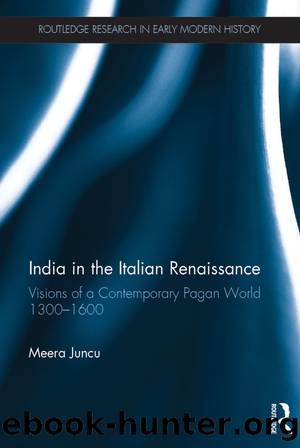India in the Italian Renaissance by Meera Juncu

Author:Meera Juncu [Juncu, Meera]
Language: eng
Format: epub
Tags: History, General, Asia, India & South Asia, Europe, Italy, Modern, 17th Century, 16th Century
ISBN: 9781317447689
Google: 3NYkDwAAQBAJ
Publisher: Routledge
Published: 2015-07-30T03:37:57+00:00
Perpetuation of classical motifs
As the fifteenth century progressed, the range of classical texts available to writers expanded enormously: the Latin translations made under the patronage of Pope Nicholas V (r.1447â1455) included Ptolemy, Strabo, and Herodotus; by 1475, the bulk of the Latin classics were in print, and other Greek works had been translated including the Indika attributed to Arrian, and Philostratusâ Life of Apollonius of Tyana, an ancient philosopher famed for travels in India.26 Francesco Berlinghieriâs metrical cosmography Le Septe giornate della geographia is an example of the continued importance of classical visions of the East in the latter fifteenth century. It was one of the first vernacular works based on Ptolemyâs Geography to be printed, and the first to use the neologism âgeographyâ in its title. Berlinghieri (1440â1500/1) was a Florentine diplomat, pupil of Argyropolous and Landino, and frequenter of Ficinoâs Platonic Academy. He began composition of the Geographia in 1465, but it took over a decade to complete, and was eventually printed c. 1482. The published poem was accompanied by thirty-one engraved maps (twenty-seven Ptolemaic charts and four modern maps of Italy, Spain, France and Palestine).27
Although Berlinghieri asserts the superiority of âgeographiaâ to âchorographiaâ in the opening to the poem (I.2; fol. aa.iir), in what follows he does not entirely fulfil his promise to use Ptolemy as his guide and to eschew chorographic detail. There are some notable digressions in the text, such as the passages on Egyptian religion and burial rites (IV.8â9; fols. b.irâb.iir), while Book Three has elaborate descriptions of Italy drawn from various sources ancient and modern, including Strabo and Flavio Biondo.28 For Marica Milanesi, Berlinghieriâs Geographia is a remarkable work of synthesis that combines all the various currents in geographical studies of the century.29 Nevertheless, its sections on the Indias âdentroâ and âfora il gangeâ, this side of the Ganges and beyond it, read largely as a rhymed list of names with minimal other detail to break up the monotony. Such details when they do occur either indicate the nature of a settlement, commercial or otherwise, or they recall classical versions of the legends about Alexander or Hercules in India, the gymnosophists, the Brahmins, widow-burning or the fabulous races of men.30 Unlike the European and Mediterranean sections of the book, where Berlinghieri has revised information and place names to accord with contemporary writings, the Indian sections have not been updated in the light of contemporary sources.31 In Berlinghieriâs account of India, Poggioâs representation of India has been discarded in favour of the ancient authority of Ptolemy, Strabo, and Pliny.
In other humanist literature of the period, Indians were for the most part only of anecdotal interest. This is most obvious in the philosophical dialogues, where Indian customs serve as exempla to help further a discussion or argue a point. Given that such dialogues were also a means to display oneâs erudition (and to test the readerâs), it is not surprising that the provenance of an anecdote often goes unmentioned, even though traceable to a classical source.
Download
This site does not store any files on its server. We only index and link to content provided by other sites. Please contact the content providers to delete copyright contents if any and email us, we'll remove relevant links or contents immediately.
| Ancient & Classical | Arthurian Romance |
| Beat Generation | Feminist |
| Gothic & Romantic | LGBT |
| Medieval | Modern |
| Modernism | Postmodernism |
| Renaissance | Shakespeare |
| Surrealism | Victorian |
4 3 2 1: A Novel by Paul Auster(12231)
The handmaid's tale by Margaret Atwood(7643)
Giovanni's Room by James Baldwin(7122)
Asking the Right Questions: A Guide to Critical Thinking by M. Neil Browne & Stuart M. Keeley(5582)
Big Magic: Creative Living Beyond Fear by Elizabeth Gilbert(5562)
Ego Is the Enemy by Ryan Holiday(5235)
The Body: A Guide for Occupants by Bill Bryson(4892)
On Writing A Memoir of the Craft by Stephen King(4830)
Ken Follett - World without end by Ken Follett(4602)
Adulting by Kelly Williams Brown(4444)
Bluets by Maggie Nelson(4436)
Eat That Frog! by Brian Tracy(4392)
Guilty Pleasures by Laurell K Hamilton(4284)
The Poetry of Pablo Neruda by Pablo Neruda(3997)
Alive: The Story of the Andes Survivors by Piers Paul Read(3929)
White Noise - A Novel by Don DeLillo(3920)
Fingerprints of the Gods by Graham Hancock(3906)
The Book of Joy by Dalai Lama(3862)
The Bookshop by Penelope Fitzgerald(3728)
